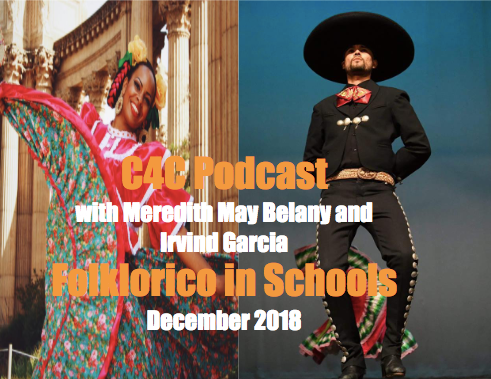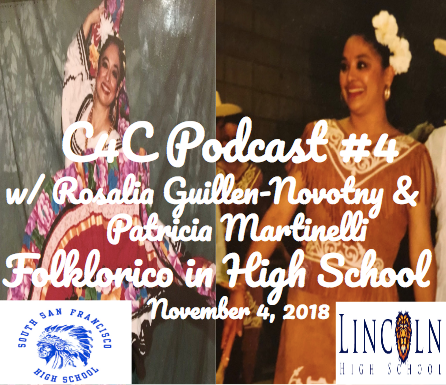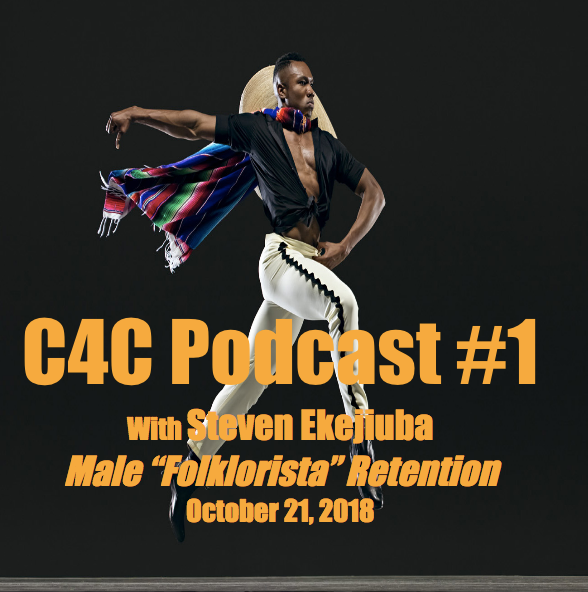Podcast #4: Folklorico in K-12 Schools
- Christopher Sandoval

- Oct 4, 2018
- 4 min read
Updated: Dec 18, 2018
Certified elementary school educators and folklorico teachers Meredith May Belany will be engaging with C4C director Christopher Sandoval about the current hardships and benefits of seeing Mexican folk dance or folklorico being institutionalized within the elementary school setting.

Preface:
When a member of the folklorista community approaches an age of transition from student to teacher, the preparation process is never easy. Considering that Mexican folk dance has been in the US public school system across the Southwest and Texas since the 1970's, I wonder just how much more feasible and sustainable the job has become today for someone like me. In this podcast I attempt to scratch the surface of these questions with two other educators in which we are all implementing Mexican folk dance in our own schools in a different capacity, and where we already serve as certified early childhood/elementary teachers. We will discuss three topics: Shaping a Folklorico Curriculum, Building Resources, and Advocating For a School Folklorico Program.
Podcast Highlights:
Shaping a Folklorico Curriculum (led by Irvind Garcia):
Align your dance material with your students' socio-emotional skills, critical thinking skills, and body awareness skills.
Align your dance material and age group with the state's and national dance standards that work for you.
Be able to articulate and demonstrate the difference between your pedagogy (philosophy behind why they learn what they learn) and your practice (the scope and sequence of how and what they learn)
Find the skills dance and cultural relevancy can tap into making any student successful in any social setting (social, thinking, health, etc.)
Integrating history and cultural characteristics within dance instruction organically
Being intentional with what students may need, invest in, and appreciate such as skirt work vs. zapateado, or son jarocho vs. jalisco
Ensuring that the curriculum is student-centered, hands-on, and allows students to learn with instruments, accessories, and each other.
Tap into how students' families can connect with your dance material
1) California State Dept. of Education Dance Standards: https://www.cde.ca.gov/be/st/ss/damain.asp
2) National Dance Standards:
https://www.ndeo.org/content.aspx?page_id=22&club_id=893257&module_id=159040
Building Resources (led by Meredith May Belany):
Using your student's cultural background and experiences
Propose for funding by building a visual presentation/proposal to administration, parents, and community leaders. Expect resistance, and have a plan to follow up. Schools have money, it depends how they choose to spend it, stretch it, and ask for it from their district and external resources.
Financial resources such as fundraiser websites can be very useful in funding for an array of dance and other school-related items. Common ones used by educators are www.donorschoose.org, www.booster.com, and www.gofundme.com.
Presenting your proposal to local credit unions and city banks for funding as they have educational grants can earn you not just possible funding, but an important networking relationship.
Taking your proposal to your community after-school programs such as the Boys and Girls Club and the YMCA that serve the same community your students live in can also be an option in getting funding, and even a space.
Kaiser Permanente, the hospital system, also holds funding through their outreach programs that address and battle obesity.
Building your social capital and networking with the yearly festival Danzantes Unidos (www.danzantes.org) and annual congress Asociación Nacional de Grupos Folkloricos (www.angfdance.com/conference) can earn you great funding opportunities by just meeting the right person!
The National Endowment for the Humanities (https://www.neh.gov/) provides grants for certified teachers and professors.
Aim high in your funding proposal, funders will usually never give you more than that you ask for.
BUILD YOUR PERSONAL LIBRARY. There is an array of literature that we encourage you to write down from the podcast. Here are some personal favorites from us:
1) Dancing Across Borders: Danzas y Bailes Mexicanos edited by Dr. Olga Najera-Ramirez (adult read)
2) The Man Who Set The Town Dancing by Candice Stanford (child read aloud)
3) Danza! Amalia Hernández and El Ballet Folklórico de México by Duncan Tonatiuh (child read aloud)
4) Dancing Across Mexican History (1325-1910) by Dr. Gabriela Mendoza-Garcia (adult read)
5) The Folklorico Handbook by Rudy Garcia (adult read)
6) A Treasury of Mexican Folkways by Francis Toor (adult read)
7) The Girl and the Fandango by Yesenia Hunter (child read aloud)
Advocating For A School Folklorico Program (led by Christopher Sandoval):
Talk to your student's parents. Once they are on board, they will help advocate for you to your school leadership. Happy students, happy parents, happy school leaders.
Other than a school site level, take it a step further go to the school district with a proposal in hand and ask to schedule a meeting!
Make yourself aware of professional panels and online communities that treasure the arts as a focus.
Don't be afraid to reach out to more experienced maestros around you, because they are usually open to lend you advice and even support!
Findings
As we attempted to scratch the surface of the benefits, struggles, and lessons learned of establishing a school folklorico program in whichever capacity you choose; it is important to always know you have professional support through others around you. Building social capital and networking needs to be a constant practice. Furthermore, you should always see the need to grow individually in multiple ways as a social practitioner (personal library, attend workshops, etc.). The road will usually never be easy, and balance takes a new challenge. Personally, I question how much our folklorista predecessors have come together across a school district, state region, coalition, etc. to build an educational and job pipeline for their folklorista students who wish to continue folklorico as a space maker (educator, director, historian, choreographer, etc.). I wonder how I can provide a road map for my students who wish to continue folklorico as space makers when I have left the field.





Comments